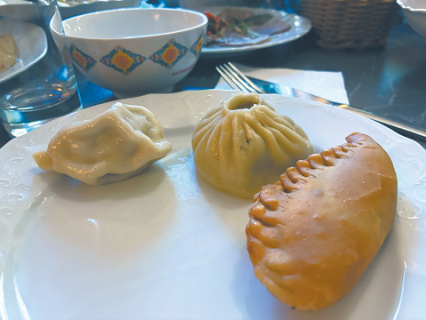
The Republic of Kalmykia, nestled in the vast steppes of southern Russia, stands as a unique cultural anomaly – the only Buddhist-majority region in Europe. It represents a living testament to nomadic heritage, offering a distinct and often surprising experience for those who venture into its heartland. A recent journey into this captivating land revealed a tapestry woven from ancient traditions, compelling cuisine, and an enduring spirit that continues to shape its identity.
The initial approach to Kalmykia often begins with the sprawling urban landscape of Volgograd, a stark contrast to the anticipated endless steppes. What might start as a quest for sun-drenched horizons and grazing herds can quickly turn into an overnight passage through darkness, the journey to the capital, Elista, illuminated only by vehicle headlights. Yet, the true encounter with Kalmykia unfolds with the dawn, revealing the vast, open landscapes that define its soul.
At the core of Kalmyk identity lies its cuisine, a reflection of centuries of nomadic existence. Rich in meat, these dishes are designed for sustenance during long journeys across the steppe. Kalmyks, renowned cattle breeders, possess an intimate knowledge of animal anatomy, traditionally capable of butchering an animal with a single knife. Meals often commence with a hearty broth like Makhn, accompanied by Bortsg, an unleavened flatbread fried in mutton fat. Those unaccustomed to such robust fare might find the culinary landscape challenging, but deeply rewarding.
A true culinary marvel is Küür, a dish that embodies both tradition and patience. This elaborate preparation involves a whole or partial lamb, slow-cooked within a sheep’s stomach in an underground pit. The process is a ritual in itself, requiring the excavation of a pit, intense heating with fire, and then layering the stuffed stomach with sheepskin, dried dung for fuel, and earth. After a full day of subterranean roasting, the result is a tender, flavorful meat, infused with the essence of the Kalmyk steppe itself. Experts suggest the sheep’s wool acts as a natural insulator, regulating the temperature as the dung smolders, ensuring perfect succulence.
Beyond its savory heart, Kalmykia also offers an array of delightful baked goods, with Bortsg appearing again in a sweeter, bun-like form. Yet, perhaps the most intriguing sweet delicacy is Bulmug, a rare dessert prepared from a traditional recipe involving sour cream, apple jam, butter, and water, yielding a delicate, non-cloying yogurt-like taste. Complementing these treats is Kalmyk tea, a ubiquitous daily beverage brewed with milk, butter, salt, nutmeg, and bay leaf. Known for its ability to quench thirst in heat and provide warmth in cold, its authentic taste, like the potent Kumys – fermented mare’s milk often served with a word of caution about its pungent aroma – is best experienced directly in its homeland.
Venturing into the steppe itself, particularly at sites like Tseren Park, offers a profound connection to Kalmykia’s nomadic past. Visitors are often greeted by the imposing Kalmyk camels, known for their immense size, one of which famously accompanied explorer Fedor Konyukhov on an expedition tracing the ancient Oirat migration route from Mongolia. Such encounters are often accompanied by traditional folk songs, evoking the deep reverence for nature and ancestral ties that permeate Kalmyk culture.
The influence of Kalmykia extends even into the annals of Russian literature. Legend has it that the renowned poet Alexander Pushkin, upon tasting Kalmyk tea, found it so invigorating that it momentarily straightened his famous curls, inspiring lines like “Farewell, dear Kalmyk girl!” His fascination with the East was reportedly fueled by his friendship with Archimandrite Iakinf Bichurin, an orientalist and traveler. Pushkin’s works, including “The Captain’s Daughter” and his celebrated poem “I erected a monument to myself…,” feature references to Kalmyks, underscoring their integral, if sometimes romanticized, place in the broader narrative of Russian identity.
Cultural preservation is powerfully embodied in Tod Bichig, the unique Old Kalmyk script. Gifted by the Oirat-Kalmyk scholar Zaya Pandita, it represents one of the few ancient writing systems that Kalmyks have successfully preserved to this day. A growing interest in Tod Bichig is evident, with local designers incorporating its elegant forms into contemporary fashion, bridging ancient heritage with modern aesthetics. As one scholar, Evgeny Bembeev, noted, this script is “stitched into the cultural code of the Kalmyk people,” and its revival among younger generations is seen as crucial for the resurgence of the Kalmyk language and cultural identity. It is a powerful symbol of continuity, with visitors often leaving with their names inscribed in the ancient script, carrying wishes for peace, harmony, and happiness.
The journey concludes with the indelible image of endless steppes, now visible in daylight, dotted with grazing livestock, accompanied by the contemporary sounds of local artists. As a rap song by Johny El, “Region 08,” might proclaim, Kalmykia leaves a lasting impression: its distinctive faces, warm hospitality, ingrained culture centered around Buddhism, unforgettable cuisine, and unique beverages. It offers a powerful testament to a heritage that, despite centuries of change, continues to thrive and warmly welcome those who seek to understand its enduring spirit.
